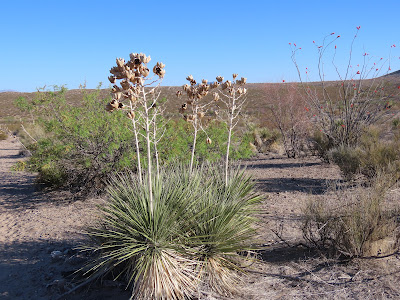
The staff here at COC are encouraged to do independent research, but only Research Associate Becca takes the suggestion seriously. Here she is (in the middle distance in the photo at left) conducting research on her own. Her main area of interest is the jackrabbit, but she has a fervent preoccupation with all manner of desert flora and fauna, especially rodents (which worries me a lot). Becca is the newest member of COC, coming aboard about five months ago. We sent her to training classes about a month after she was hired on, but she didn't do well in school. Her instructor said that Becca was too much of a class clown, and didn't take lessons seriously. The teacher told me personally the very last thing you want to hear about somebody you have high hopes for: that Becca had "potential." Unfortunately, good help is almost impossible to come by nowadays, and you have to work with what you've got.
Take Chappy and George, for instance. When they first came to COC they did extensive fieldwork. They were invaluable in advancing the institution's mission. But now they never venture out, and they spend most of their time in their offices doing nothing. Since our budget is tight, and we pay them next to nothing, we can't afford to let them go.
Then there's Dr. K., who's the major fundraiser around here. If it wasn't for her, there'd be no COC. Other than that, though, it's hard to figure out what she's doing with her time. More than once we've caught her sitting at her computer playing crossword puzzles or Free Cell. If she suspects that somebody's watching, she quickly closes the game and pretends she's working on articles. (An interesting aside: Yesterday afternoon, Dr. K. returned to the center in a foul mood. She had stopped by the grocery store to purchase one item--ground beef for dinner--and had had a mild confrontation with the checkout clerk, who had given back the wrong change. Pleased with herself for confronting the clerk, Dr. K. walked out of the store without her package, and drove all the way back here before realizing it. When she told me about it, I could hardly keep from laughing. When I mentioned it to the others, Chappy said, "Who goes to the store for one item and then leaves without it?" "Dr. K.," we all said in unison.)














































